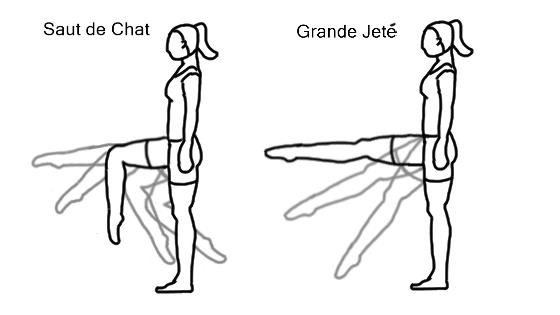Why Saut de Chats are Easier than Grande Jetés
When I was a young dancer, I learned grande jetés as my first big leap. It was the more “traditional” ballet leap, and it was easy to transfer “straight knees, pointed toes” from grande battements to jetés. However, when we learned saut de chats (another name for grande jeté developpé) a few years later, they instantly became the favorite of my whole class.
I’ve seen this happen with nearly every ballet class I’ve been in or taught. People love saut de chats! In fact, I don’t think I’ve ever met someone who prefers grande jetés to saut de chats. Why is that?
Personally, I’ve always preferred saut de chats because it’s so much fun to pop your legs into a split. It’s easier to show the power and energy that should be present in a leap. Grande jetés just feel like lifting weights.
But for this preference to be a universal phenomenon, there must be some explanation for saut de chats being easier and more fun. And there is! There’s actually a scientific explanation for why saut de chats are easier than grande jetés.
The difference between the two
Real quick before we start, I just want to clarify the difference between saut de chats and grande jetés. It’s easy to get them confused, and the explanation of which is easier won’t make much sense if you don’t know which is which!
A grande jeté is a leap that begins with a grande battement (straight leg kick) and a saut de chat is a leap that begins with a developpé (lift a bent knee, then straighten the leg), as you can see in this picture:

Now that we’re all clear on the difference, let’s get into the details of why saut de chats are easier than grande jetés.
How you get into the air
As I described in detail in my post about the physics of leaps, the height of a grande jeté or saut de chat comes from the swing of your front leg. Knowing that, you would think that a grande jeté would be easier to jump high because you get a bigger swing. Not so!
You do get a bigger swing with a battement, so theoretically you should get higher off the ground, but there is more than one ingredient to a high leap. You need a big swing and a lot of momentum, and it’s harder to get momentum in a battement than it is in a developpé. Check out this diagram to see what I mean:

You can see that a saut de chat actually includes two small swings, while a grande jeté includes just one big swing. The two small swings take much less muscle power, so it’s easier to get a lot of momentum. A lot of momentum = more height = easier and more fun!
So in conclusion: saut de chats are easier than grande jetés because it’s easier to get upward momentum by swinging the leg in two parts than by kicking the leg straight.
Related post: How to Improve Your Leaps with Simple Physics







